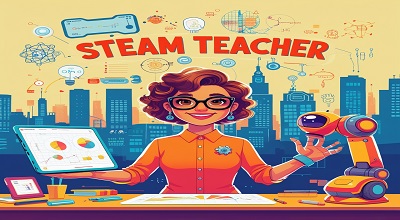STEAM Teacher Development
STEAM Teacher Development: STEAM (Science, Technology, Engineering, Arts, and Mathematics) education is an interdisciplinary approach that integrates creativity and critical thinking into traditional STEM fields. Unlike STEM, which focuses primarily on technical skills, STEAM incorporates the arts to foster innovation and problem-solving.
Why STEAM Matters in Modern Education
- Encourages creativity and innovation
- Prepares students for future workforce demands
- Bridges the gap between technical and artistic disciplines
- Enhances collaboration and teamwork
With the rapid advancement of technology, STEAM education has become essential in preparing students for careers in AI, robotics, and sustainable development.
The Importance of STEAM Teacher Development
Teachers play a crucial role in delivering effective STEAM education. However, many educators lack the necessary training to implement STEAM methodologies successfully.
Key Reasons for Investing in STEAM Teacher Development
- Keeps educators updated with new technologies and teaching methods.
- Improves student engagement through hands-on, project-based learning.
- Encourages interdisciplinary teaching, breaking subject silos.
- Boosts confidence in handling advanced tools like coding, 3D printing, and AI.
Without proper professional development, teachers may struggle to keep up with evolving educational demands.
Latest Trends in STEAM Teacher Training
The field of STEAM teacher development is rapidly evolving. Here are the most impactful trends in 2024:
A. Micro-Credentialing and Digital Badges
Many institutions now offer short, competency-based courses that allow teachers to earn digital badges. These micro-credentials focus on specific skills like robotics, coding, or AI integration.
B. Gamified Professional Development
Platforms like Kahoot! and Minecraft Education are being used to train teachers in an interactive, game-based environment.
C. AI and VR in Teacher Training
- AI-powered coaching provides real-time feedback on teaching methods.
- Virtual Reality (VR) simulations help teachers practice STEAM lessons in a risk-free environment.
D. Collaborative Learning Communities
Online forums, such as Microsoft Educator Community and Google for Education, enable teachers to share resources and best practices globally.
E. Focus on Equity and Inclusion
New PD programs emphasize culturally responsive teaching to ensure STEAM education is accessible to all students, regardless of background.
Effective Strategies for STEAM Professional Development
To maximize the impact of STEAM teacher training, schools and institutions should adopt the following strategies:
A. Hands-On Workshops
- Teachers engage in project-based learning (e.g., building robots, coding apps).
- Encourages experiential learning.
B. Peer Coaching and Mentorship
- Experienced STEAM educators mentor newcomers.
- Promotes collaborative problem-solving.
C. Industry Partnerships
- Schools partner with tech companies (Google, Apple, NASA) for real-world training.
- Teachers gain insights into current industry trends.
D. Continuous Learning Platforms
- Subscription-based platforms like Coursera, edX, and Udemy offer STEAM-focused courses.
E. Reflective Teaching Practices
- Teachers record and review their lessons for self-improvement.
- Encourages adaptive teaching methods.
Challenges in STEAM Teacher Development
Despite its benefits, STEAM teacher development faces several hurdles:
A. Lack of Funding
Many schools cannot afford advanced STEAM training programs.
B. Resistance to Change
Some educators prefer traditional teaching methods over STEAM integration.
C. Limited Access to Technology
Rural and underfunded schools struggle with outdated tools.
D. Time Constraints
Teachers often have packed schedules, leaving little room for PD.
E. Assessment Difficulties
Measuring the effectiveness of STEAM teaching remains a challenge.
Future of STEAM Education and Teacher Growth
The future of STEAM teacher development includes:
- AI-driven personalized PD
- Global teacher collaboration networks
- More government and corporate funding
- Increased focus on sustainability and green tech
Educators who embrace these changes will lead the next generation of innovators.
Conclusion
STEAM teacher development is critical for preparing students for a tech-driven future. By adopting the latest trends—such as micro-credentials, AI coaching, and gamified learning—educators can enhance their teaching methods and inspire students.
